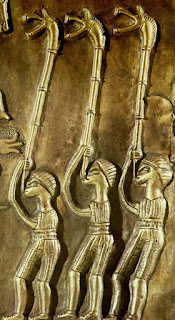Dragon Voices: The giant Celtic horns of Ancient Europe; John Kenny; Delphian
Reviewed by Robert Hugill on Nov 22 2016
Star rating:
Reconstructed ancient Celtic instruments brought to life
This disc is part of the European Music Archaeology Project on Delphian, and this disc turns its attention to the music made on Celtic horns. John Kenny plays the Tintignac carnyx, the Deskford carnyx and the Loughnashade horn.
Reviewed by Robert Hugill on Nov 22 2016
Star rating:
Reconstructed ancient Celtic instruments brought to life
This disc is part of the European Music Archaeology Project on Delphian, and this disc turns its attention to the music made on Celtic horns. John Kenny plays the Tintignac carnyx, the Deskford carnyx and the Loughnashade horn.
The carnyx is a long Celtic trumpet, made from beaten bronze and surmounted by the tylised head of a boar. We find the work in various classical texts, including the accounts of the Julius Caesar's campaign in Gaul, and the instrument was widely depicted in Celtic images, notably the Gundestrup cauldron (the most important surviving example of Celtic Iron Age silver work). The Deskford carnyx was discovered in 1816 in Deskford, Banffshire, though only the head survives and the remainder has had to be re-constructed based on visual images. In 2004, archaeologists found a first-century BC deposit of seven carnyxs at Tintignac in the Correze region of southern France. Quite a number of instruments have survived in Ireland, and the one on this disc is a copy of one found in a peat bog in Loughnashade, Co. Armagh in 1794. All three instruments, including the speculative reconstruction of the Deskford carnyx, have a very similar fundamental which suggests that there was some sort of commonality to the instruments across the Celtic culture.
 |
| Carnyx players on the Gundestrup cauldron |
The disc includes a pair of informative articles, one on the instruments and one on the music, as well as numerous pictures but what we never learn is how difficult the instruments are to play. But there is no doubt that the results are highly evocative and create a remarkable sound-world. There is something fascinating and intriguing about the instruments' lowest registers, and in the higher ones they prove remarkably mobile. Kenny plays a number of instruments, and multi-tracks, so the we get some really orchestral effects.
Inevitably the music itself overlaps with contemporary practise, it couldn't not. This is probably not a disc for regular listening, but it help us to understand greater the sound world of the Celtic era.
John Kenny - Tintignac carnyx, Deskford carnyx, Loughnahade horn
Recorded 18-20 November 2015, University of Huddersfield Recording Studios
DELPHIAN CDC34183 1CD [66.42]
Available from Amazon.co.uk.
Elsewhere on this blog:
- Winning charm: Raphaela Papadakis and Sholto Kynoch at Omnibus Clapham - concert review
- Fifty mad minutes: Gerald Barry Alice's Adventures Under Ground - opera review
- Crossing boundaries: My interview with conductor Robert Ames - interview
- Music at its centre: Peter Schaffer's Amadeus at the National Theatre - theatre review
- Solo viola: Rosalind Ventris in Blake, Bach and Roxburgh - concert review
- Diversity alone makes for all that is perfect: Marc-Antoine Charpentier at Kings Place - concert review
- Lots of taste, not much excess: Le Coucher du Soleil at Kings Place - concert review
- Engaging vitality: La Nuova Musica in Cavalli's La Calisto - concert review
- Re-discovering the saxhorn: The Celebrated Distin Family - CD review
- The American violin concerto: Tamsin Waley-Cohen plays Adams and Harris - CD review
- Radical re-invention: Joyce DiDonato in War & Peace - concert review
- RVW rarities: Purer than pearl from Albion Records - CD review
- Home









.jpeg)


No comments:
Post a Comment